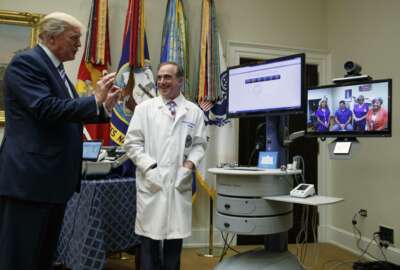
VA.gov relaunch a catalyst for DevOps, enterprise cloud migration
The Department of Veterans Affairs said it plans to move 350 existing applications to the VA Enterprise Cloud by 2024.
Best listening experience is on Chrome, Firefox or Safari. Subscribe to Federal Drive’s daily audio interviews on Apple Podcasts or PodcastOne.
The Department of Veterans Affairs’ recent relaunch of its main website, VA.gov, has been a catalyst for change for the agency’s technology modernization efforts.
Improving veterans’ experience with the VA site was the obvious, ultimate goal. So far, the agency’s efforts appear to be paying off.
Since the department launched the new version of VA.gov, online health applications have increased by 50 percent compared to the same period last year, Charles Worthington, VA’s chief technology officer, said Wednesday at AFCEA Bethesda’s Health IT Summit in Maryland.
But the overall approach with the VA.gov relaunch is sparking a broader evolution at the department’s Office of Information and Technology. For Worthington, recent investments in DevOps best practices and VA’s approach to enterprise cloud migration are beginning to pay dividends.
The VA digital services team used agile development and DevOps best practices to reimagine and consolidate the department’s main websites. But it was also the VA digital services team that set the example and migrated VA.gov to the department’s growing enterprise cloud.
Since then, the department has been building out the VA enterprise cloud with Amazon Web Services and Microsoft Azure as development environments.
“That approach, though it took a little while to get started, has been pretty successful in making it possible for multiple teams at the VA to start migrating their applications to the cloud without having to rediscover how to procure the cloud on their own,” Worthington said. “We’re seeing a lot more traction getting applications out of our own data centers and other leased facilities into the commercial cloud, which is a big win for us.”
VA said in it’s in for the long haul with its enterprise cloud effort. The department currently has about 900 applications, though not all will move the cloud, said Dave Catanoso, director of VA’s enterprise cloud solutions office.
VA is moving existing applications in quarterly waves. The goal, he said, is to move about 350 applications into the VA enterprise cloud by 2024.
“We’re confident not all are going to go to the VA enterprise cloud,” Catanoso said. “Some might go to a software-as-a-service solution, and others might be decommissioned over time.”
From a security standpoint, VA said its enterprise cloud environment is reducing both development time and security costs.
Application developers “used to do almost 387 controls and had to work through a whole process,” said Joe Fourcade, a VA IT specialist. “Now, we’ve … streamlined it to go through the cloud and cut down that amount of time for them to get up to getting their ATOs [authorities to operate], getting them operational throughout cloud. It also reduces that cost overall for the project.”
It also frees up more time for developers to develop — and not worry as much about clearing the application through the security controls process. It used to take two-to-three weeks to clear an app through the controls process. Now, it takes about a day, Fourcade said.
The department migrated its identity and access management application to the cloud over the summer. The move has saved VA nearly $1 million a month, a 66 percent reduction in hosting costs, Fourcade said.
It’s still unclear how VA will move the Veterans Information Systems and Technology Architecture (VistA) to the department’s enterprise cloud, especially given the department’s plans to eventually retire VA’s homegrown electronic health record and adopt the same commercial, off-the-shelf electronic health record as the Defense Department.
“We’re still doing a VistA pilot, for example, to see if we’ll move VistA to the cloud,” Catanoso said. “The idea is that we would have a standardized cloud environment that would be shared across the VA and make it easier for pilots like that to be done, because they wouldn’t have to go out and do their own cloud build-out and worry about all those things that we’ve already addressed.”
VA’s interactions with DoD in implementing the new Cerner system has led to other collaborations. The department will eventually use DoD’s supply chain asset management system by fiscal 2022, said Aaron Drew, a senior enterprise solutions architect for VA.
“Our data is still going back into the DoD environment,” he said. “DoD’s providing all the equipment, we’re leveraging their backbone, and eventually we’ll leverage their cloud implementation.”
The ultimate goal is to continue the push to consolidate and abandon data centers and repurpose the space for something else, said Alan Constantian, deputy chief information officer and health account manager for VA’s Office of Information and Technology.
“Having a server room that we can convert into clinical space is always welcome by the medical center staff,” he said. “They’d rather have that than a bunch of machines taking up the valuable space in the medical centers.
Copyright © 2024 Federal News Network. All rights reserved. This website is not intended for users located within the European Economic Area.
Nicole Ogrysko is a reporter for Federal News Network focusing on the federal workforce and federal pay and benefits.
Follow @nogryskoWFED





